Related Research Articles
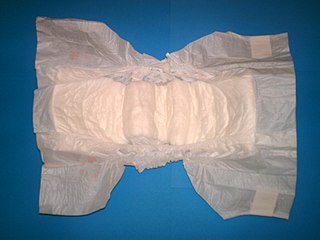
A diaper /ˈdaɪpə(r)/ or a nappy is a type of underwear that allows the wearer to urinate or defecate without using a toilet, by absorbing or containing waste products to prevent soiling of outer clothing or the external environment. When diapers become wet or soiled, they require changing, generally by a second person such as a parent or caregiver. Failure to change a diaper on a sufficiently regular basis can result in skin problems around the area covered by the diaper.
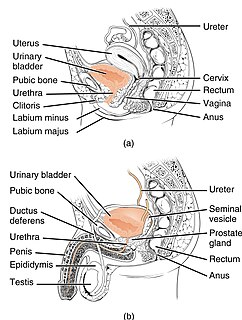
Urinary incontinence (UI), also known as involuntary urination, is any uncontrolled leakage of urine. It is a common and distressing problem, which may have a large impact on quality of life. It has been identified as an important issue in geriatric health care. The term enuresis is often used to refer to urinary incontinence primarily in children, such as nocturnal enuresis.

A tampon is a menstrual product designed to absorb blood and vaginal secretions by insertion into the vagina during menstruation. Unlike a pad, it is placed internally, inside of the vaginal canal. Once inserted correctly, a tampon is held in place by the vagina and expands as it soaks up menstrual blood. However, in addition to menstrual blood, the tampon also absorbs the vagina's natural lubrication and bacteria, which can change the normal pH, increasing the risk of infections from the bacterium Staphylococcus aureus, which can lead to toxic shock syndrome (TSS). TSS is a rare but life-threatening infection that requires immediate medical attention.

A menstrual pad, or simply pad, is an absorbent item worn by women in their underwear when menstruating, bleeding after giving birth, recovering from gynecologic surgery, experiencing a miscarriage or abortion, or in any other situation where it is necessary to absorb a flow of blood from the vagina. A menstrual pad is a type of menstrual hygiene product that is worn externally, unlike tampons and menstrual cups, which are worn inside the vagina. Pads are generally changed by being stripped off the pants and panties, taking out the old pad, sticking the new one on the inside of the panties and pulling them back on. Pads are recommended to be changed every 3–4 hours to avoid certain bacteria that can fester in blood; this time also may differ depending on the kind worn, flow, and the time it is worn.
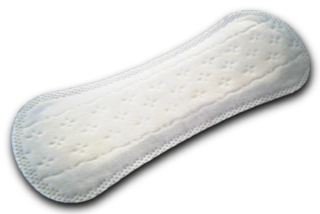
A pantyliner is an absorbent piece of material used for feminine hygiene. It is worn in the gusset of a woman's panties. Some uses include: absorbency for daily vaginal discharge, light menstrual flow, tampon and menstrual cup backup, spotting, post-intercourse discharge, and urinary incontinence. Panty liners can also help with girls who are having discharges and about to start their cycle. Pantyliners are related to sanitary napkins in their basic construction—but are usually much thinner and often narrower than pads. As a result, they absorb much less liquid than pads—making them ideal for light discharge and everyday cleanliness. They are generally unsuitable for the menstruation medium to heavy flow, which requires them to be changed more often.
An incontinence pad is a small, impermeable multi-layered sheet with high absorbency that is used in the incontinence and health-care industries as a precaution against urinary incontinence. It is generally made of cotton if washable or paper if disposable. Incontinence diapers are a common incontinence pad. Incontinence pads are usually placed in an undergarment or on a bed or chair under a person. Incontinence pads are manufactured in light and heavy grades which offer a range of absorbencies, often referred to as a 'working capacity', which refers to the true absorbency an incontinence pad offers when in use. These sorts of pads can come as panty-liners, inserts, pads or even available as replacement underwear.
Training pants are undergarments used by incontinent people, typically young children, as an aid for toilet training. They are intended to be worn in between the transition between wearing diapers but before they are ready to wear regular underpants. Training pants may be reusable and made of fabric, or they may be disposable. In the US, disposable training pants may also be referred to as "pull-ups", and in the UK, training pants are frequently referred to as nappy pants or trainer pants. The main benefit of training pants over diapers is that unlike traditional diapers, they can be easily pulled down in order to sit on a potty or toilet, and pulled back up for re-use after the person has used the toilet. The main benefit of wearing training pants over regular underpants is that if the person has an accident, they do not soil their environment.

Sodium polyacrylate (ACR), also known as waterlock, is a sodium salt of polyacrylic acid with the chemical formula [−CH2−CH(CO2Na)−]n and has broad applications in consumer products. This super-absorbent polymer (SAP) has the ability to absorb 100 to 1000 times its mass in water. Sodium polyacrylate is an anionic polyelectrolyte with negatively charged carboxylic groups in the main chain. Sodium polyacrylate is a chemical polymer made up of chains of acrylate compounds. It contains sodium, which gives it the ability to absorb large amounts of water. When dissolved in water, it forms a thick and transparent solution due to the ionic interactions of the molecules. Sodium polyacrylate has many favorable mechanical properties. Some of these advantages include good mechanical stability, high heat resistance, and strong hydration. It has been used as an additive for food products including bread, juice, and ice cream.
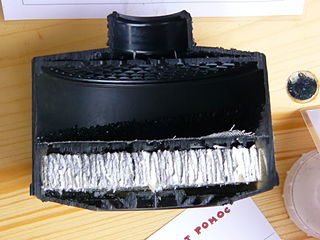
A sorbent is a material used to absorb or adsorb liquids or gases. Examples include:
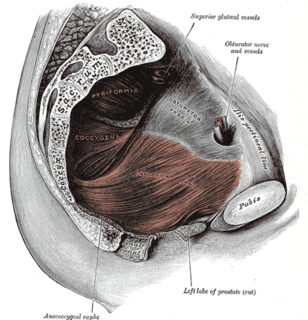
Stress incontinence, also known as stress urinary incontinence (SUI) or effort incontinence is a form of urinary incontinence. It is due to inadequate closure of the bladder outlet by the urethral sphincter.

Wood wool, known primarily as excelsior in North America, is a product made of wood slivers cut from logs. It is mainly used in packaging, for cooling pads in home evaporative cooling systems known as swamp coolers, for erosion control mats, and as a raw material for the production of other products such as bonded wood wool boards. In the past it was used as stuffing, or padding, in upholstery, or to fill stuffed toys. It is also sometimes used by taxidermists to construct the armatures of taxidermy mounts.

A superabsorbent polymer (SAP) is a water-absorbing polymer that can absorb and retain extremely large amounts of a liquid relative to its own mass.
Omorashi, sometimes abbreviated as simply omo, is a form of fetish subculture originating and predominately recognized in Japan, in which participants experience arousal from having a full bladder or wetting themselves, wearing a diaper, or from seeing someone else experiencing a full bladder or wetting themselves.

An adult diaper is a diaper made to be worn by a person with a body larger than that of an infant or toddler. Diapers can be necessary for adults with various conditions, such as incontinence, mobility impairment, severe diarrhea or dementia. Adult diapers are made in various forms, including those resembling traditional child diapers, underpants, and pads resembling sanitary napkins. Superabsorbent polymer is primarily used to absorb bodily wastes and liquids.
A Maximum Absorbency Garment (MAG) is an adult-sized diaper with extra absorption material that NASA astronauts wear during liftoff, landing, and extra-vehicular activity (EVA) to absorb urine and feces. It is worn by both male and female astronauts. Astronauts can urinate into the MAG, and usually wait to defecate when they return to the spacecraft. However, the MAG is rarely used for this purpose, since the astronauts use the facilities of the station before EVA and also time the consumption of the in-suit water. Nonetheless, the garment provides peace of mind for the astronauts.
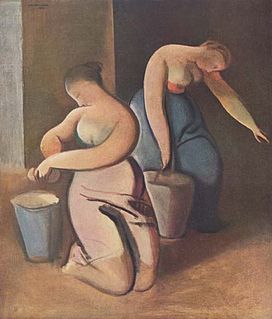
Floor cleaning is a major occupation throughout the world. The main job of most cleaners is to clean floors.
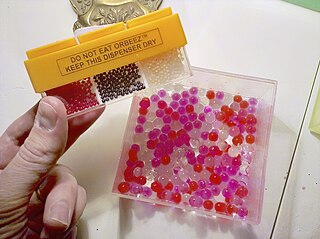
Expandable water toys are novelty items made from a superabsorbent polymer. They are toys that expand after putting them into water for several days. They shrink in saltwater or when exposed to air. They are made from polymers that can absorb and retain extremely large amounts of a liquid relative to their own mass.
Richard Yeo is a Chinese American scientist with 17 U.S. patents, best known for his research on disposable diapers.
Depend is a brand of absorbent, disposable underwear and undergarments for people with urinary or fecal incontinence. It is a Kimberly-Clark brand, and positions its products as an alternative to typical adult diapers. Depend is the dominant brand of disposable incontinence garments in the United States with a 49.4 share of the market.
Incontinence underwear is a type of reusable undergarment designed to absorb urine. It provides an alternative to traditional disposable incontinence products, which are often bulky and plastic-based. Due to concerns about the environmental impact of disposable products, incontinence underwear is becoming an alternative to pads. Only recently has the textile technology existed to enable the design and manufacture of reusable products with comparable functionality to a disposable pad or diaper.
References
- M Fader, A Cottenden, K Getliffe, H Gage, S Clarke-O’Neill, K Jamieson, N Green, P Williams, R Brooks and J Malone-Lee, "Absorbent products for urinary/faecal incontinence: a comparative evaluation of key product designs", Health Technology Assessment, vol. 12, no. 29, 2008.
- A.M Cottenden, J.G Rothwell, H Leander, C Grau, R.J Brooks, "An investigation of the repeatability and reproducibility of ISO 11948-1 (the Rothwell method) for measuring the absorption capacity of incontinence pads", Medical Engineering & Physics, vol. 24, iss. 2, pp. 159–163, March 2002.
- ISO 11948-1:1996, "Urine-absorbing aids -- Part 1: Whole-product testing", International Organization for Standardization, 1996